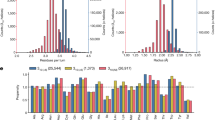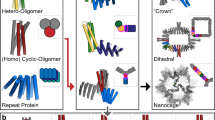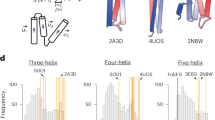Abstract
Abiotic foldamers, that is foldamers that have backbones chemically remote from peptidic and nucleotidic skeletons, may give access to shapes and functions different to those of peptides and nucleotides. However, design methodologies towards abiotic tertiary and quaternary structures are yet to be developed. Here we report rationally designed interactional patterns to guide the folding and assembly of abiotic helix bundles. Computational design facilitated the introduction of hydrogen-bonding functionalities at defined locations on the aromatic amide backbones that promote cooperative folding into helix–turn–helix motifs in organic solvents. The hydrogen-bond-directed aggregation of helices not linked by a turn unit produced several thermodynamically and kinetically stable homochiral dimeric and trimeric bundles with structures that are distinct from the designed helix–turn–helix. Relative helix orientation within the bundles may be changed from parallel to tilted on subtle solvent variations. Altogether, these results prefigure the richness and uniqueness of abiotic tertiary structure behaviour.
This is a preview of subscription content, access via your institution
Access options
Access Nature and 54 other Nature Portfolio journals
Get Nature+, our best-value online-access subscription
$29.99 / 30 days
cancel any time
Subscribe to this journal
Receive 12 print issues and online access
$259.00 per year
only $21.58 per issue
Buy this article
- Purchase on Springer Link
- Instant access to full article PDF
Prices may be subject to local taxes which are calculated during checkout





Similar content being viewed by others
References
Guichard, G. & Huc, I. Synthetic foldamers. Chem. Commun. 47, 5933–5941 (2011).
Zhang, D. W., Zhao, X., Hou, J. L. & Li, Z. T. Aromatic amide foldamers: structures, properties, and functions. Chem. Rev. 112, 5271–5316 (2012).
Gellman, S. H. Foldamers: a manifesto. Acc. Chem. Res. 31, 173–180 (1998).
Goodman, C. M., Choi, S., Shandler, S. & DeGrado, W. F. Foldamers as versatile frameworks for the design and evolution of function. Nat. Chem. Biol. 3, 252–262 (2007).
Nair, R. V., Vijayadas, K. N., Roy, A. & Sanjayan, G. J. Heterogeneous foldamers from aliphatic-aromatic amino acid building blocks: current trends and future prospects. Eur. J. Org. Chem. 2014, 7763–7780 (2014).
Lokey, R. S. & Iverson, L. B. Synthetic molecules that fold into a pleated secondary structure in solution. Nature 375, 303–305 (1995).
Brüggemann, J. et al. Spontaneous knotting—from oligoamide threads to trefoil knots. Angew. Chem. Int. Ed. 46, 254–259 (2007).
Ponnuswamy, N., Cougnon, F. B. L., Clough, J. M., Pantoş, G. D. & Sanders, J. K. M. Discovery of an organic trefoil knot. Science 338, 783–785 (2012).
Hua, Y., Liu, Y., Chen, C. H. & Flood, A. H. Hydrophobic collapse of foldamer capsules drives picomolar-level chloride binding in aqueous acetonitrile solutions. J. Am. Chem. Soc. 135, 14401–14412 (2013).
Chandramouli, N. et al. Iterative design of a helically folded aromatic oligoamide sequence for the selective encapsulation of fructose. Nat. Chem. 7, 334–341 (2015).
Huang, P.-S. et al. De novo design of a four-fold symmetric TIM-barrel protein with atomic-level accuracy. Nat. Chem. Biol. 12, 29–34 (2016).
Boyken, S. E. et al. De novo design of protein homo-oligomers with modular hydrogen-bond network-mediated specificity. Science 352, 680–687 (2016).
Hilvert, D. Design of protein catalysts. Annu. Rev. Biochem. 82, 447–470 (2013).
Khoury, G. A., Smadbeck, J., Kieslich, C. A. & Floudas, C. A. Protein folding and de novo protein design for biotechnological applications. Trends Biotechnol. 32, 99–109 (2014).
Parmeggiani, F. et al. A general computational approach for repeat protein design. J. Mol. Biol. 427, 563–575 (2015).
Price, J. L. et al. Design of a three-helix bundle capable of binding heavy metals in a triscysteine environment. Angew. Chem. Int. Ed. 49, 368–371 (2010).
Grigoryan, G. & Degrado, W. F. Probing designability via a generalized model of helical bundle geometry. J. Mol. Biol. 405, 1079–1100 (2011).
Joh, N. H. et al. De novo design of a transmembrane Zn2+-transporting four-helix bundle. Science 346, 1520–1524 (2014).
Woolfson, D. N. The design of coiled-coil structures and assemblies. Adv. Protein Chem. 70, 79–112 (2005).
Gradišar, H. et al. Design of a single-chain polypeptide tetrahedron assembled from coiled-coil segments. Nat. Chem. Biol. 9, 362–366 (2013).
Reinert, Z. E., Lengyel, G. A. & Horne, W. S. Protein-like tertiary folding behavior from heterogeneous backbones. J. Am. Chem. Soc. 135, 12528–12531 (2013).
Mayer, C., Müller, M. M., Gellman, S. H. & Hilvert, D. Building proficient enzymes with foldamer prostheses. Angew. Chem. Int. Ed. 53, 6978–6981 (2014).
Tavenor, N. A., Reinert, Z. E., Lengyel, G. A., Griffith, B. D. & Horne, W. S. Comparison of design strategies for α-helix backbone modification in a protein tertiary fold. Chem. Commun. 52, 3789–3792 (2016).
Horne, W. S., Price, J. L., Keck, J. L. & Gellman, S. H. Helix-bundle quaternary structure from α/β-peptide foldamers. J. Am. Chem. Soc. 129, 4178-4180 (2007).
Cheng, P. N., Pham, J. D. & Nowick, J. S. The supramolecular chemistry of β-sheets. J. Am. Chem. Soc. 135, 5477–5492 (2013).
Kreutzer, A. G., Hamza, I. L., Spencer, R. K. & Nowick, J. S. X-ray crystallographic structures of a trimer, dodecamer, and annular pore formed by an Aβ17-36 β-hairpin. J. Am. Chem. Soc. 138, 4634–4642 (2016).
Daniels, D. S., Petersson, E. J., Qiu, J. X. & Schepartz, A. High-resolution structure of a β-peptide bundle. J. Am. Chem. Soc. 129, 1532–1533 (2007).
Petersson, E. J., Craig, C. J., Daniels, D. S., Qiu, J. X. & Schepartz, A. Biophysical characterization of a β-peptide bundle: comparison to natural proteins. J. Am. Chem. Soc. 129, 5344–5345 (2007).
Collie, G. W. et al. Shaping quaternary assemblies of water-soluble non-peptide helical foldamers by sequence manipulation. Nat. Chem. 7, 871–878 (2015).
Sharma, G. V. M. et al. Design and synthesis of peptides with hybrid helix–turn–helix (HTH) motif and their conformational study. J. Org. Chem. 79, 8614–8628 (2014).
Delsuc, N., Massip, S., Léger, J. M., Kauffmann, B. & Huc, I. Relative helix–helix conformations in branched aromatic oligoamide foldamers. J. Am. Chem. Soc. 133, 3165–3172 (2011).
Ichinose, W., Ito, J. & Yamaguchi, M. Tetrameric ααββ aggregate formation by stereoisomeric bidomain helicene oligomers. Angew. Chem. Int. Ed. 52, 5290–5294 (2013).
Gan, Q. et al. Translation of rod-like template sequences into homochiral assemblies of stacked helical oligomers. Nat. Nanotech. 12, 447–452 (2017).
Kent, S. B. H. Total synthesis of proteins. Chem. Soc. Rev. 38, 338–351 (2009).
Pusterla, I. & Bode, J. W. An oxazetidine amino acid for chemical protein synthesis by rapid, serine-forming ligations. Nat. Chem. 7, 668–672 (2015).
Haj-Yahya, M. et al. Synthetic polyubiquitinated α-synuclein reveals important insights into the roles of the ubiquitin chain in regulating its pathophysiology. Proc. Natl Acad. Sci. USA 110, 17726–17731 (2013).
Jiang, H., Léger, J. M. & Huc, I. Aromatic δ-peptides. J. Am. Chem. Soc. 125, 3448–3449 (2003).
Delsuc, N. et al. Kinetics of helix-handedness inversion: folding and unfolding in aromatic amide oligomers. ChemPhysChem 9, 1882–1890 (2008).
Qi, T. et al. Solvent dependence of helix stability in aromatic oligoamide foldamers. Chem. Commun. 48, 6337–6339 (2012).
Maurizot, V. et al. Design of an inversion center between two helical segments. J. Am. Chem. Soc. 126, 10049–10052 (2004).
Sánchez-García, D. et al. Nanosized hybrid oligoamide foldamers: aromatic templates for the folding of multiple aliphatic units. J. Am. Chem. Soc. 131, 8642–8648 (2009).
Neidigh, J. W., Fesinmeyer, R. M. & Andersen, N. H. Designing a 20-residue protein. Nat. Struct. Biol. 9, 425–430 (2002).
Hodges, A. M. & Schepartz, A. Engineering a monomeric miniature protein. J. Am. Chem. Soc. 129, 11024–11025 (2007).
Craven, T. W., Cho, M. K., Traaseth, N. J., Bonneau, R. & Kirshenbaum, K. A miniature protein stabilized by a cation–π interaction network. J. Am. Chem. Soc. 138, 1543–1550 (2016).
Lommerse, J. O. S. P. M., Price, S. L. & Taylor, R. Hydrogen bonding of carbonyl, ether, and ester oxygen atoms with alkanol hydroxyl groups. J. Comput. Chem. 18, 757–774 (1997).
Acknowledgements
This work was supported by the European Research Council under the European Union's Seventh Framework Programme (Grant Agreement no. ERC-2012-AdG-320892), by the European Union under the People program (FP7 PIIF-2009-254156 postdoctoral fellowship to T.Q.) and by the French–Chinese Foundation for Science and its Applications (postdoctoral fellowship to B.C.). The contribution of S. Post in optimizing the synthesis of 4-tBuO-protected quinoline monomers is acknowledged. The authors thank B. Kauffmann for assistance with X-ray data collection and structure resolution at the Institut Européen de Chimie et Biologie's X-ray diffraction facility and M. Ferrer for beam time and help during the data collection on FIP-BM30A at the European Synchrotron Radiation Facility.
Author information
Authors and Affiliations
Contributions
S.D. and B.C. contributed equally to this work. S.D., B.C. and T.Q. synthesized all the new compounds, carried out the solution studies and grew single crystals. T.G. refined the crystal structures. I.H. and V.M. designed the research and carried out the modelling studies. I.H. wrote the manuscript. All the authors discussed the results and commented on the manuscript.
Corresponding author
Ethics declarations
Competing interests
The authors declare no competing financial interests.
Supplementary information
Supplementary information
Supplementary information (PDF 11176 kb)
Supplementary information
Supplementary Movie 1 (MP4 27586 kb)
Supplementary information
Supplementary Movie 2 (MP4 18672 kb)
Supplementary information
Supplementary Movie 2 (MP4 30242 kb)
Supplementary information
Crystallographic data for compound 1a (CIF 5632 kb)
Supplementary information
Crystallographic data for compound 2a (CIF 10802 kb)
Supplementary information
Crystallographic data for compound 2b (CIF 6669 kb)
Supplementary information
CCrystallographic data for compound 3a (CIF 32066 kb)
Supplementary information
Crystallographic data for compound 4a (CIF 18673 kb)
Supplementary information
Crystallographic data for compound 5a (CIF 10602 kb)
Rights and permissions
About this article
Cite this article
De, S., Chi, B., Granier, T. et al. Designing cooperatively folded abiotic uni- and multimolecular helix bundles. Nature Chem 10, 51–57 (2018). https://doi.org/10.1038/nchem.2854
Received:
Accepted:
Published:
Issue Date:
DOI: https://doi.org/10.1038/nchem.2854
This article is cited by
-
Hierarchically self-assembled homochiral helical microtoroids
Nature Nanotechnology (2022)
-
Hierarchical communication of chirality for aromatic oligoamide sequences
Nature Communications (2021)
-
A versatile living polymerization method for aromatic amides
Nature Chemistry (2021)
-
Proteomimetics as protein-inspired scaffolds with defined tertiary folding patterns
Nature Chemistry (2020)



